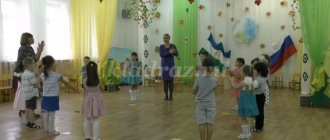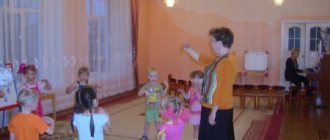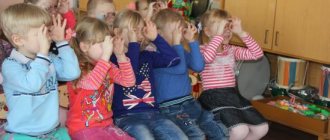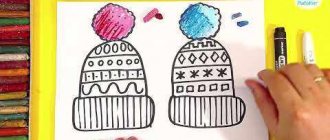Music classes in kindergarten
Classes are divided into individual, subgroup and frontal, depending on the number of children participating in them.
Individual lessons and in subgroups are conducted with children of early and primary preschool age, when children are not yet able to complete tasks collectively. This type of activity is also used in other groups to pay attention to the development of each child.
Frontal classes are conducted with the entire group of children. They represent all types of musical activities.
In terms of content, classes can be standard, dominant, thematic, complex, depending on the use of various types of musical activities and the presence of a theme.
A typical lesson includes all types of musical activities. In dominant - some type of musical activity predominates. As an option for a dominant lesson, building content for the development of lagging musical abilities. In such a case, those types of musical activity that can develop it dominate. This type of classes is used in frontal, individual and subgroup classes.
In a thematic lesson, a topic is chosen that unites all types of activities; it can be frontal, individual and in subgroups. A complex lesson contains different types of art, types of artistic activity, can be frontal and is carried out with the entire group of children.
The teacher needs to vary the types of activities depending on the age of the children and their level of musical development.
Lessons are individual and in subgroups.
Children are admitted to preschool educational institutions from the age of one and a half years. At this age, the child needs special attention from an adult. He is not yet able to coordinate his actions with the actions of others, so music lessons are held individually twice a week for 5-10 minutes. At 1.5-2 years old, children can already walk freely, run, and begin to master speech, but they do not yet have experience communicating with other children. A feature of a typical lesson in early age groups is the unity of all sections, the combination of various types of musical activities. The child listens to music and reacts to its character with movements, can sing along without words, or wave a toy to the beat of the music. To enhance the emotional reaction of children, a comparison of contrasting works is used.
To form a stable positive attitude towards music, gaming techniques, toys, and attributes are widely used. Individual lessons are conducted not only with young children. This is due to the fact that all children develop differently, as well as the specifics of musical activity, which involves contact with each child individually. In terms of content, individual lessons are predominantly dominant. Not only one type of activity can predominate; the activity can be aimed at developing any musical ability. Not only children who are lagging behind, but also children who are ahead of their peers in development need individual lessons. Classes with retarded children make it possible to find the cause of developmental delays.
Individual lessons are necessary when learning and playing musical instruments. Classes in subgroups are conducted in the same cases as individual ones, their varieties are the same. Dominant classes in subgroups help identify similar deficiencies in the musical development of several children. Children who show aptitude for certain types of activities are also grouped into subgroups. At such classes, collective performances are prepared to show them to the rest of the children at the festive matinee. You can also learn to play musical instruments in subgroups. When children have mastered the initial skills of playing in individual lessons, they are taught to play in an ensemble or orchestra.
Frontal exercises. Dominant activities. Thematic classes. Complex classes.
Gradually, the content of the classes is approaching frontal ones. Individual classes and subgroup classes are conducted as needed. In middle and older age, frontal exercises become the main type of exercise. They are also divided into typical, dominant, thematic and complex. Typical classes include all types of musical activities. But often, due to the short class time, it is impossible to use all types of activities. The main condition is that the absence of any type of activity is not permanent.
Practice shows that listening to music and playing musical instruments are used least often in classes; singing and musical-rhythmic movements predominate. This is a big mistake, since the absence of the “Listening to Music” section impoverishes children’s musical experiences, and playing musical instruments contributes to the development of musical ear, which is not enough for singing alone. Listening to music develops the most important musical ability - emotional responsiveness to music, which is necessary for successful learning of all types of musical activities. Frontal classes have a traditional structure, but it is necessary to constantly vary it so that interest in musical classes does not disappear.
Structure of the frontal lesson:
- entrance to music. Gradually the music needs to change.
- musical and rhythmic exercises.
- the children sit down, and the teacher moves on to the sections “Listening to music”, “Singing” and “Playing musical instruments, including creative tasks.
- at the end of the lesson - a song or game.
- going out to music.
This version uses all types of musical activities. Musical and educational activities do not have a special place in the structure. Children receive information about music and methods of action throughout the lesson.
The variability of the structure of a musical lesson is manifested in the combination of two types of musical activity: listening with musical-rhythmic movements or playing instruments, singing with musical-rhythmic movements or playing instruments. Such options allow you to increase children's interest in the lesson and in music. It is necessary to carefully consider the order of tasks: singing after dancing is difficult, tasks that require emotional and mental activity are best given at the beginning of the lesson, regulate the physical and mental state of children by changing the type of activity, loads, and the nature of the sound of music.
Dominant activities. Thematic classes. Complex classes.
This type of activity is used to develop any musical ability. For example:
1. If the predominant type of activity is the perception of music, then other types of activities can be used so that children can not only listen to music, but also express the nature of music using the performing and creative skills that they already possess: in movement, in playing musical instruments .
2. If singing dominates, the teacher concentrates on the development of vocal and choral skills. Other types of activities help them acquire the skills they need in singing: in order for the performance to be expressive, it is useful to have a conversation about the character and moods that are to be conveyed to the children; the technique of comparison with other songs that are contrasting in character or similar to the song being performed is appropriate. To avoid monotony, you can use games with singing and round dances.
3. If musical-rhythmic movements dominate, such an activity is accompanied by listening to music and talking about its character, which children must convey in movements. In such classes, creative tasks and guessing games are widely used, children improvise dance movements, and collectively compose dances.
4. If playing musical instruments dominates, you can expand their understanding of various musical instruments by listening to recordings of the sound of various musical instruments, playing games to guess the timbres of various instruments, and using a creative task to orchestrate a piece.
5. If children's musical creativity dominates, you can use all its varieties - singing, musical-rhythmic, music-making.
Thematic classes. Complex classes.
There are three varieties: actual thematic, musical-thematic, plot, depending on the nature of the chosen topic and the presence of a plot. The theme can be taken from life and related to music, for example, “Autumn”, “Nature and Music”. A thematic lesson is sometimes held instead of a matinee. Instead of a concert, the teacher talks about interesting events from history and life dedicated to the holiday, accompanies the story with the sound of recorded music, children can perform their favorite songs and dances (not necessarily dedicated to the holiday). These free activities have a stronger impact on children than a rote activity.
In a music - themed lesson, the topic is related to the music itself, for example, such topics as “Tempo in music and its expressive meaning”, “Timbre in music”, “Dynamics”, etc.
The plot-based musical activity is not only united by a common theme, but has a single storyline. A fairy tale or game plot makes the activity entertaining, exciting, develops imagination, and gives scope for creative imagination. Depending on the storyline, children are offered creative tasks in which they must not only compose a melody, but also convey a certain mood in it. Game and fairy-tale situations are used in classes in the form of fragments. The main requirement for such an activity is that the activity should not be of the nature of entertainment or a rehearsed event. All types of thematic classes are used in each age group, differing only in the content of the repertoire and information about music.
Complex classes.
The purpose of such classes is to give children an idea of the specifics of various types of art, the expressive features of their artistic means, the ability to convey thoughts and moods in any type of artistic activity in their own original language. Therefore, it is necessary not formally, but thoughtfully to combine different types of art, to find similarities and differences in the works and means of expression of each type of art. A complex lesson has the same varieties as a thematic lesson. A theme taken from life or related to a fairy tale helps to trace how the same image is conveyed by different artistic means, to find similarities and differences in moods and their shades.
It is important that the change in artistic activity is not formal in nature, but is united by the task of conveying a mood similar to music in drawing, movements, and poetry. If the works are not consonant in figurative content, but are only united by a common theme, it is necessary to draw the children’s attention to the contrast of moods. On the topic “Fairy-tale characters” it is necessary to trace how the same image is conveyed in different types of art, as well as compare several musical works written on the same topic. It is more difficult to conduct a complex lesson, the topic of which is art itself, the features of expressive means. Complex lessons are prepared by the music director together with the teacher in order to use all the knowledge and skills that children have acquired in other lessons. These classes are held approximately once a month.
Magic box
Summary of a dominant musical lesson for children of the preparatory group using musical
didactic games.
The “Magic Box” music lesson was designed to develop children’s musicality and ability to perceive music emotionally.
Training tasks:
consolidate ideas about the varieties of the dance genre, the rhythmic pattern of the mazurka and polka; to form modal tonal and pitch hearing.
Developmental tasks:
develop emotional responsiveness to musical works, the ability to understand the content and character of musical pieces, creative imagination through musical and rhythmic movements.
Educational tasks:
to cultivate love and interest in classical music and the work of P.I. Tchaikovsky.
Equipment:
piano, music center, flannelgraph.
Demo material:
music Box; “accordion” made of colored paper; Major and Minor dolls, Major and Minor hats; cube with images of musical instruments; snowflakes, fake snowball; diagrams of dance figures.
Handout: "
accordions" made of paper; white chiffon scarves; children's musical instruments.
Progress of the lesson
(Children enter the hall to the “March of the Wooden Soldiers” by P.I. Tchaikovsky, their attention is drawn to the music box.)
Music hands:
Guys, today I discovered this box of riddles.
If we guess them, the box will remain in our garden. There is no way we can do this without your help! Are you willing to help? (Children agree.)
The box is not simple, it is musical!
You, box, open quickly.
Try very, very hard to make it more fun.
Our box is full of secrets and songs,
She will reveal musical secrets to us.
(The teacher opens the box from which music sounds and takes out an “accordion” folded out of paper.)
Music hands:
This harmonica can perform magical transformations depending on the music!
If a polka sounds, it will turn into a skirt, if a mazurka sounds, it will turn into a fan, and if a waltz sounds, it will turn into a butterfly. (The teacher demonstrates the transformations of the “accordion”.)
Let's try it!
(In the musical and didactic game “Accordion-Talker”, children perform these transformations to the sounds of “Children’s Polka” by M.I. Glinka, “Nata Waltz” and “Mazurka” by P.I. Tchaikovsky.) Music
. hands:
Well done! How did you manage to accurately distinguish a mazurka from a polka?
Children:
She has her own rhythmic pattern, not the same as the polka.
Music hands:
Let's clap it to remember it better!
(The game “Repeat the rhythm” is played. Children clap the rhythmic pattern of the mazurka.)
Now let’s clap the rhythmic pattern of the first musical phrase of the polka and lay it out on a flannelgraph.
(Children clap the rhythmic pattern of a polka, and one child lays it out with icons indicating long and short sounds.)
Music. hands:
Is there anything else in the box?
(The teacher takes out the Major and Minor dolls.)
Guys, who is this? What fairy tale are they from?
Children:
These are Major and Minor from "Tales of Music".
Music hands:
Tell me, what is Major’s character?
What does he like? What can you say about Minor? (Children answer questions.)
Today these two musical modes will appear in our lesson.
(The teacher puts the Minor and Major hats on the two children.)
Minor:
Guys, guess which winter fairy tale this snowflake is from?
(Shows a snowflake.)
What dance did she dance with her friends?
Music hands:
A snowball will help Minor answer.
Whoever holds it in his hands will talk about music. (The “Waltz of Snow Flakes” by P.I. Tchaikovsky sounds; children pass the snowball to each other.)
Children:
The music is fabulous, magical, fast-paced, flying, exciting.
Music hands:
Guys, what instrument sounds suit this music?
Look at the cube and choose! (Children look at images of musical and noise instruments on the faces of the cube.)
Children:
A bell, a triangle, and bells are suitable. They have a “cold” sound.
Music hands:
How interesting it is to watch falling snowflakes!
Each performs its own dance, spinning in the air. Let's make a blizzard! Get into the circle quickly and hold hands tightly! You girls will spin around and turn into snowflakes! Hey boys, jump and jump, turn into a breeze! (A musical and didactic game “Convey the character of music with movements” is being held. To the music of P.I. Tchaikovsky “Waltz of Snow Flakes”, girls with scarves improvise a dance of snowflakes, boys imitate the wind; children who have chosen musical instruments play along with them.)
Music. hands:
It turned out to be a wonderful waltz of snow flakes!
Now you will spin around and turn into kids. (The teacher brings a snowflake to his ear.)
Winter comes to us cheerful, cheerful.
Children, the snowflake wants to hear a song. Major will help you guess it. (When performing the game exercise “Recognize the song by your lips,” Major sings without sound, the children guess and call the song “Come, Winter.”)
Music. hands:
Just now a blizzard was swirling here, we depicted it with movements, and now we’ll try to convey the howling of the wind in a voice.
(Children perform a phonopedic exercise.)
Blizzards whistled: “Oooh”
(glissando from bottom to top)
;
snow was flying: “Oh-oh-oh” (glissando from top to bottom)
.
She made the beds with frost: “Ah-ah” (glissando from top to bottom)
.
What is the character of this winter song? (Children answer.)
Try to convey the character of the music in your singing.
(Preschoolers sing the song “Come, Winter!”, music by E. Bolshakova.)
Major:
Now is the time to play in the snow and go sledding!
Music hands:
Let's continue to learn a fun dance!
(The teacher demonstrates diagrams of 3 elements of the 1st dance figure. Children are learning the dance-game “Russian Winter”, music by L. Olifirov.)
Music. hands:
Guys, what is the nature of this music?
Which mode can it be classified as: major or minor? (Children answer this and the following questions.)
Let's remember what types of dance genre do you know?
What dances did we listen to today? Which Russian composer's music did you try to depict with movements? Do you think you succeeded? Guys, you completed all the tasks! The music box remains with us, and it still contains many different secrets. (Surprise moment: Major and Minor give snowflakes to the children.)
Svetlana Kozhedub, music. Supervisor
MBDOU D/s No. 81 “Electronic”, Novorossiysk
The topic of my speech is “Dominant activities”
The topic of my speech is “Dominant activities.”
In the structure of the dominant occupation, one type of musical activity prevails. Used to develop any musical ability and activate the child. If a certain type of musical activity (others, auxiliary) predominates in the dominant lesson, children purposefully master the necessary skills of this particular activity. To develop a lagging ability, it is necessary to group all types of activities around tasks that help improve it.
Let's consider several options for dominant activities.
If the predominant activity in the lesson is the perception of music, all other types of musical activities can be used so that children learn not only to perceive the nature of music, but also to express it with the help of those performing and creative skills that they already possess. Children can convey the character of music in different ways: with movements or, by choosing an expressive timbre of musical instruments that matches the mood of the works, and having orchestrated the piece, perform it on children's musical instruments (accompanied by a piano).
The whole activity is subordinated to one goal - to attract children to the sound of music so that they can express its character in various ways, with the help of other activities.
If singing dominates the lesson, the teacher has the opportunity to concentrate on vocal and choral skills: sound production, breathing, diction, purity of intonation, ensemble, subordinating them to the expressiveness of children's performance. Other activities help children acquire the skills they need in singing. So that the performance of the song is expressive, it is useful to have a conversation about the character and moods that are to be conveyed to the children in its different parts. The technique of comparison with other songs and plays that are contrasting in nature or similar to the song being performed is also appropriate here.
Thus, listening to music and talking about its content alternate with singing.
While singing and during the lesson, the children are offered creative tasks. To understand the nature of sound production and diction, children can use hand movements (smooth or clear) and play musical instruments (drum, pipe).
The lesson will not be static if you include folk games with singing and round dances.
The purity of intonation in singing depends on whether children are aware of the direction of movement of the melody. Therefore, it is recommended to use playing musical instruments, which allows you to simulate the direction of movement of the melody that children will then convey with their voice, as well as musical and didactic games. Thus, listening to music, musical-rhythmic movements and playing musical instruments help improve the quality of singing.
If musical and rhythmic movements dominate, such an activity is also accompanied by listening to music and talking about its character, which the children will have to convey in movements. You can stage and orchestrate round dances with singing, which involve the development of action. The inclusion of musical games (plot-based, non-plot-based) into the lesson makes it entertaining, allows you to improve auditory attention, the ability to timely and expressively convey the change in the nature of music. In such classes, creative tasks and guessing games with elements of pantomime (depictions of animals, etc.) are widely used. Children improvise dance movements and create dances collectively.
Game and competitive techniques allow you to differentiate tasks for the entire group, subgroups, and each child.
With the dominance of playing musical instruments, in addition to teaching children the necessary skills, you can expand their understanding of various musical instruments (folk and instruments, symphony orchestra), and with the help of audio recordings, introduce children to the expressive capabilities of each instrument.
There are also games to guess the timbres of instruments. In such classes, it is appropriate to orchestrate a piece using the expressive timbres of various instruments.
The dominant activity with a predominance of children's musical creativity can include its varieties - song creativity, creativity in musical and rhythmic movements, playing music on musical instruments.
In dominant classes, it is not necessary to involve everything in children’s musical activities, but to select only those that help complete the assigned tasks.
If the dominant activity is devoted to the development of one of the musical abilities and all tasks in various types of activities are aimed at solving this problem, appropriate musical-didactic games and exercises are selected.
Dominant activities may have a specific theme or plot. They are held from 3 to 12 times per quarter.
Example Dominant activity is singing. Electronic presentation.
Get text






